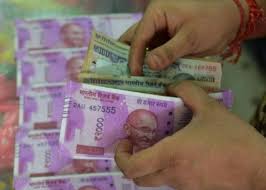India’s rupee hits record low as emerging markets struggle

India’s rupee is the latest currency to be dragged down by fears that a trade war could hurt global economic growth.
The rupee dropped to a record low against the US dollar on Thursday, a slide fueled by fears over trade conflicts and higher oil prices that could drag down the major energy importer’s economy. The stronger dollar and expectations of higher US interest rates were also major factors in the rupee’s fall.
A growing number of emerging markets are coming under pressure from the same forces. The Argentine peso and Turkish lira are among the hardest hit, falling in recent weeks to all-time lows against the US dollar.
Global investors are moving their money from foreign markets to the United States to capitalize on a strengthening economy and rising interest rates. Meanwhile, the risk of a global trade war has intensified concerns about a broad economic slowdown outside the United States that would hammer emerging markets.
Tariffs raise the price of imported goods, increasing costs for manufacturers and pushing up inflation.
The trends have made US dollar assets more appealing, and pushed up the value of the greenback against a basket of currencies by 7.5% in the past five months.
Jim Vogel, a fixed income strategist at FTN Financial Capital Markets, said economists were convinced until a few weeks ago that emerging market damage would be contained, with just three or four countries suffering most of the damage.
“Their insistence was well reasoned if just a little too confident,” he said, pointing to weak economic data out of China and a stock plunge that has pushed the country’s benchmark index into bear market territory.
The Chinese yuan has fallen more than 3% against the dollar in the past two weeks as trade tensions with the United States have worsened.
Chinese companies have amassed huge levels of US dollar debts in recent years through bond sales in Hong Kong, according to financial data provider Dealogic. When the yuan slides versus the dollar, it makes it more expensive for the companies to pay back those debts.
Worries in Asia
Other Asian economies are much more vulnerable than China.
The Thai baht has slipped to its lowest level of the year, Indonesia’s rupiah is at its weakest point since late 2015 and the Malaysian ringgit has been sinking since March.
“While the speed of selling has slowed down compared to the early part of the week, emerging market currencies have continued to show weakness,” said Jameel Ahmad, global head of currency strategy at FXTM.
A weaker currency supports exports by making products appear cheaper to international buyers. But it also hikes the price of imports, which is particularly damaging for countries that need to bring in money to pay off debts.
Moody’s warned this week that Argentina and Turkey are among the countries most vulnerable to a stronger US dollar. The credit ratings agency also singled out Pakistan, Mongolia and Ghana.
Analysts aren’t panicking just yet.
“We have not seen a major emerging market credit event so far — countries are still paying [their debts],” said Timothy Ash, a senior sovereign strategist at BlueBay Asset Management.
Central bank action
However, some central banks have been forced to act to support their currencies, hiking interest rates to levels that threaten to slow their domestic economies. And Argentina has been forced to turn to the International Monetary Fund for help.
Benchmark interest rates have been pushed up to 40% in Argentina and nearly 18% in Turkey. Ahmad said that Indonesia’s central bank may soon be forced to hike rates.
Experts warn the countermeasures may not be powerful enough.
“For as long as buying the dollar continues to be the trend of the [currency] market, there is very little emerging markets can do to prevent weakness,” added Ahmad.










